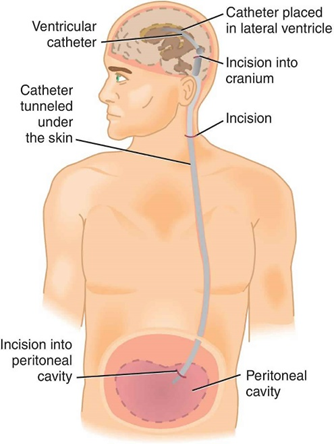A nurse is caring for an infant who has spina bifida. Which of the following actions should the nurse take?
Place the infant in prone position.
Cover the infant's lesion with a dry cloth.
Feed the infant through an NG tube.
Diapering over a low defect will keep the infant free from infection
The Correct Answer is D
A. Place the infant in prone position.
This option is incorrect. Placing the infant in the prone position (lying on the stomach) could put pressure on the spinal lesion, potentially causing discomfort or complications. It's important to minimize pressure on the affected area in infants with spina bifida.
B. Cover the infant's lesion with a dry cloth.
This option is incorrect. While keeping the lesion clean and dry is important for preventing infection, simply covering it with a dry cloth may not provide adequate protection. Proper wound care techniques, such as using sterile dressings and cleaning the area with prescribed solutions, are typically necessary to prevent infection and promote healing.
C. Feed the infant through an NG tube.
This option is incorrect. While infants with severe forms of spina bifida may have difficulty feeding due to associated complications, such as difficulty swallowing or weak sucking reflexes, feeding through a nasogastric (NG) tube is not a standard intervention for spina bifida itself. Feeding methods would depend on the specific needs and abilities of the infant, and may involve breastfeeding, bottle-feeding, or other methods under the guidance of healthcare professionals.
D. Diapering over a low defect will keep the infant free from infection.
This option is correct. Diapering over a low defect (the opening in the spine caused by spina bifida) helps to keep the area clean and reduce the risk of infection. By properly covering the defect with a diaper, exposure to urine and feces, which can increase the risk of infection, is minimized. Additionally, regular diaper changes and proper hygiene practices are essential for preventing complications in infants with spina bifida.
Nursing Test Bank
Naxlex Comprehensive Predictor Exams
Related Questions
Correct Answer is D
Explanation
A. A 45-degree head elevation: This position can help facilitate venous drainage and reduce intracranial pressure. Elevating the head of the bed may aid in preventing the accumulation of cerebrospinal fluid (CSF) in the brain, which is important after VP shunt insertion to maintain proper drainage. However, this position alone may not be sufficient.
B. On the nonoperative side: Placing the child on the nonoperative side can help reduce pressure on the side where the shunt was inserted, minimizing discomfort and the risk of disruption or displacement of the shunt. However, this position may not directly affect CSF drainage.
C. Prone: Placing the child prone (lying face down) is generally not recommended after VP shunt insertion. This position may increase pressure on the head and interfere with proper CSF drainage, potentially leading to complications.
D. Supine: Placing the child supine (lying on their back) is typically recommended after VP shunt insertion. This position helps promote proper drainage of CSF through the shunt system without placing undue pressure on the surgical site. It also allows for easy monitoring of the child's condition and surgical site.

Correct Answer is B
Explanation
A. Pulmonary function test:
Pulmonary function tests (PFTs) assess lung function by measuring airflow, lung volume, and gas exchange. While PFTs can provide valuable information about respiratory function, they are not specific to cystic fibrosis and may show abnormalities consistent with various respiratory conditions. However, PFTs are often performed in individuals with cystic fibrosis to monitor lung function over time and assess response to treatment. They are not considered the most definitive test for diagnosing cystic fibrosis.
B. Sweat chloride test:
This option is correct. The sweat chloride test is considered the most definitive diagnostic test for cystic fibrosis. It measures the concentration of chloride in sweat, which is typically elevated in individuals with cystic fibrosis due to defective chloride transport in sweat glands. A sweat chloride concentration above a certain threshold (usually ≥60 mmol/L) is diagnostic of cystic fibrosis, particularly when confirmed with repeat testing.
C. Stool fat content analysis:
Stool fat content analysis evaluates fat absorption and fecal fat excretion, which may be impaired in individuals with cystic fibrosis due to pancreatic insufficiency. However, while stool fat content analysis can provide supportive evidence of malabsorption in cystic fibrosis, it is not considered the most definitive test for diagnosing the condition. Stool fat content analysis is often used in conjunction with other diagnostic tests to assess pancreatic function and nutritional status in individuals with cystic fibrosis.
D. Sputum culture:
Sputum culture involves culturing respiratory secretions to identify bacterial pathogens, which can be useful for diagnosing respiratory infections in individuals with cystic fibrosis. However, sputum culture is not specific to cystic fibrosis and may show similar findings in other respiratory conditions. While respiratory cultures are important for guiding treatment in cystic fibrosis, they are not considered the most definitive test for diagnosing the condition.
Whether you are a student looking to ace your exams or a practicing nurse seeking to enhance your expertise , our nursing education contents will empower you with the confidence and competence to make a difference in the lives of patients and become a respected leader in the healthcare field.
Visit Naxlex, invest in your future and unlock endless possibilities with our unparalleled nursing education contents today
Report Wrong Answer on the Current Question
Do you disagree with the answer? If yes, what is your expected answer? Explain.
Kindly be descriptive with the issue you are facing.
